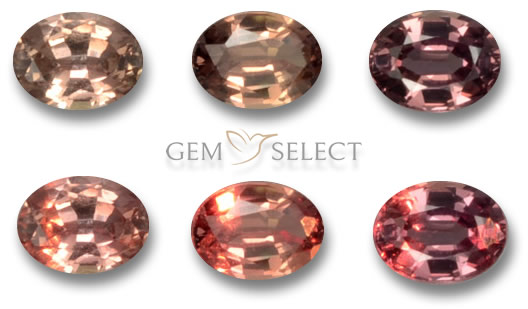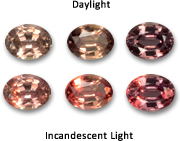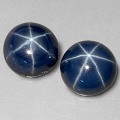Color Change Sapphire Gemstone Information

Buy Natural Color Change Sapphire from GemSelect
About Color Change Sapphire - History and Introduction
Color change sapphire is an exceptionally rare and unique variety of corundum known for its remarkable ability to change color when viewed under different lighting conditions. While blue is the most common hue, color change sapphires can also appear in shades of greenish, yellowish, pinkish, and violet-purple, depending on the specific coloring agents present in the stone. Typically, these sapphires transition from blue in natural daylight to a violet-purple under incandescent light. Top-quality color change sapphires can display a striking and noticeable shift, though most will only partially change from blue to bluish-purple. Explore our selection of color change sapphire for sale.
In order to truly appreciate color change sapphire, specimens should be observed under different lighting conditions, including early morning daylight, late afternoon daylight, fluorescent light and incandescent light. The unique and rare ability to color change occurs only in rare sapphire that forms with two light transmission windows rather than one. For example, a red gemstone appears red because it absorbs all frequencies of light except for red, but a gemstone that absorbs all frequencies of light except for blue and red appears blue when the light is rich in blue wavelengths, and red when the light source is rich in red wavelengths. Fluorescent light is rich in blue, whereas incandescent is rich in red. Natural daylight is well-balanced, which is why color change sapphire is best viewed under natural daylight.
|
|

|
Since color change sapphire is corundum, it is the second hardest mineral on earth next to diamond. Owing to its superior hardness, color change sapphire gemstone is almost unmistakable despite there being many gems that can appear similar in color and luster. As with all sapphire, fancy color change sapphire has a specific gravity of 4.00, a refractive index ranging from 1.76 to 1.78 and a birefringence of 0.008. Color change sapphire belongs to the trigonal crystal system, structured with three planes of symmetry and four axes. The exact crystal form depends on the variety and origin. Color change sapphire has no real cleavage, but it may have a conchoidal or uneven fracture.
Color Change Sapphire Origin and Gemstone Sources Back to Top Fancy color change sapphire is mined from locations around the world, including Thailand, Sri Lanka (Ceylon), Cambodia, Tanzania, Nigeria, Kenya, Madagascar, Tanzania, Australia, China and the USA. Sri Lanka (Ceylon) and Madagascar are the leading producers of fine sapphire today.
Sapphire from the Kashmir region of India, the Pailin region of Cambodia, Burma (Myanmar) and Sri Lanka (Ceylon) is considered the most valuable.
Buying Color Change Sapphire and Determining Color Change Sapphire Gemstone Value Back to Top
Color Change Sapphire Color
Fancy color change sapphire changes hue based on the source of light. The most common color shift is from blue (daylight) to bluish-purple (incandescent light), but various other color combinations are possible. Blue sapphire is colored by iron and titanium. Violet colors are owed to traces of vanadium. Iron impurities result in yellowish and greenish colored stones. Chromium is responsible for pink, while iron and vanadium combined tend to produce orange to golden stones.
Color Change Sapphire Clarity and Luster
Unlike ruby, color change sapphire typically occurs with excellent transparency and with very few inclusions, so it is often eye-clean. Most color change sapphire gemstones are quite small, but larger stones can be found with excellent clarity. Like all sapphire, color change sapphire has an attractive vitreous (glass-like) luster once cut and polished.
Color Change Sapphire Cut and Shape
Color change sapphire is typically faceted to maximize its color shift ability. Color change sapphire is available in a variety of different cuts and shapes, however, ovals, rounds and cushions are most popular since they correspond with the typical shape of sapphire rough. Color change sapphire is not often cut en cabochon since faceting maximizes color change effects.
Color Change Sapphire Treatment
Most sapphire is enhanced by heating. Typically, before it is cut, it is heated to between 1700 and 1800 degrees Celsius (3100-3300 degrees F). Although it is not common for color change sapphire, some stones may be diffused or fracture-filled. Unheated and untreated color change sapphire is very rare, but not unheard of.
Color Change Sapphire Gemological Properties: Back to Top
| Chemical Formula: |
Al2O3 - Aluminum oxide |
| Crystal Structure: |
Trigonal, doubly pointy, barrel, hexagonal pyramid and tabloid shape |
| Color: |
Various blue tones, colorless, pink, orange, yellow, green, purple, black |
| Hardness: |
9 on the Mohs scale |
| Refractive Index: |
1.762 to 1.788 |
| Density: |
3.95 to 4.03 |
| Cleavage: |
None |
| Transparency: |
Transparent, translucent, opaque |
| Double Refraction or Birefringence: |
-0.008 |
| Luster: |
Vitreous |
| Fluorescence: |
Blue sapphire: None; colorless sapphire: Orange-yellow, violet |
Please refer to our Gemstone Glossary for details of gemology-related terms.
Color Change Sapphire: Varieties or Similar Gemstones: Back to Top
 |
| Blue Star Sapphire |
Color change sapphire is an extremely rare gemstone-quality aluminum oxide. The name 'sapphire' can be used to refer to any color of gem quality corundum except for red. Red corundum is distinctly traded as ruby and has been since times of antiquity. Since sapphire can be found in areas all around the world and because it occurs in a variety of colors, several gems can be easily mistaken for sapphire, including zircon, spinel, tourmaline, topaz and even diamond. However, owing to its distinct hardness of 9 on the Mohs scale, natural sapphire can be easily distinguished from other gems.
Most Popular Similar or Related Gemstone Trade Names:
Red ruby, blue sapphire, star sapphire, star ruby, yellow sapphire, golden sapphire, orange sapphire, green sapphire, white sapphire, pink sapphire and purple sapphire are some of the most popular similar or related gemstone trade names.
Lesser-Known Similar or Related Gemstone Trade Names:
Padparadscha sapphire, Ceyon sapphire, Kashmir sapphire, cornflower blue sapphire, Pailin sapphire and black sapphire are some of the lesser-known trade names for similar or related gemstones.
Color Change Sapphire Gemstone Mythology, Metaphysical and Healing Powers Back to TopSapphire is known as a stone of wisdom and serenity. Fancy color change sapphire can be used to release mental tension and relieve depression. It can also help enhance meditation by calming the mind. For centuries, all sapphire has represented the heavens, innocence and truth. Color change sapphire can benefit many chakras, as a result of its various colors. Depending on the color, sapphire can be the zodiac stone of Taurus, Virgo, Libra, Sagittarius or Gemini. It is especially connected with the element of water and is also the planetary stone of Saturn.
Since ancient times, sapphire has been a symbol of truth, sincerity and faithfulness. It is a gem believed to bring peace, joy and wisdom to those who wear it. In the past, sapphire was used as a powerful talisman for protecting travelers, adventurers and seekers. In fact, it was thought to be so powerful that it could continue protecting the original wearer of the talisman even after was passed on to another person.
Abbes Hildegard von Bingen (1098-1179) chronicled the healing powers of gemstones in her book 'Physica'. According to her view, gemstones are formed through the powerful combination of water and fire, therefore they held powers corresponding to these phenomena. She also believed that each stone had a certain, divine blessing from God. She said this about sapphire: "Who is dull and would like to be clever, should, in a sober state, frequently lick with the tongue on a sapphire, because the gemstone's warmth and power, combined with the saliva's moisture, will expel the harmful juices that affect the intellect. Thus, the man will attain a good intellect."
| Disclaimer: Metaphysical and Alternative Crystal Healing Powers and Properties are not to be taken as confirmed advice. Traditional, Ceremonial and Mythological Gemstone Lore is collected from various resources and is not the sole opinion of SETT Co., Ltd. This information is not to replace the advice of your doctor. Should you have any medical conditions, please see a licensed medical practitioner. GemSelect does not guarantee any claims or statements of healing or astrological birthstone powers and cannot be held liable under any circumstances. |
Color Change Sapphire Gemstone and Jewelry Design Ideas Back to TopColor change sapphire is perfectly suitable for any type of jewelry application. It is especially ideal for everyday rings, due to its extreme hardness and durable nature. Sapphire jewelry looks best under natural daylight or fluorescent lighting, rather than incandescent light. Lighter color change sapphire is best for exhibiting brilliance, whereas darker stones are more valued for their deep color. Color change sapphire is typically used for high-end jewelry, rather than mainstream or commercial jewelry, particularly owing to its extreme rarity and high price per carat.
Sapphire is one of the 'precious four' gems, which also includes red ruby, green emerald and fine diamond. Sapphire is one of the few varieties of colored gemstones that is easily available and often found in local retail jewelry stores. Next to diamond, sapphire is one of the most popular gems of today and can be found in just about every design from exquisite brooches, pins, pendants, rings and necklaces to classic and simple designs such as sapphire studs or earrings.
Note: Buy colored gemstones by size and not by carat weight. Colored stones vary in size-to-weight ratio. Some stones are larger and others are smaller than diamond by weight in comparison.
Color Change Sapphire Gemstone and Jewelry Care and Cleaning Back to Top Fancy color change sapphire can be cleaned using a soft cloth or brush and plain warm soapy water. After wiping, be sure to rinse your fancy sapphire well to remove all soapy residue. Sapphire can change color under extreme heat, so avoid extreme temperature fluctuations. Also avoid the use of any harsh household chemicals and cleaners, including bleach or hydrofluoric acid, as chemicals can cause corrosion. Fancy color change sapphire can be cleaned using a soft cloth or brush and plain warm soapy water. After wiping, be sure to rinse your fancy sapphire well to remove all soapy residue. Sapphire can change color under extreme heat, so avoid extreme temperature fluctuations. Also avoid the use of any harsh household chemicals and cleaners, including bleach or hydrofluoric acid, as chemicals can cause corrosion.
Like all sapphire, color change sapphire is quite durable, but it is still recommended that any jewelry be removed before engaging in vigorous physical activities, especially when exercising or playing sports. When removing jewelry, do not pull from the stone as this can weaken prongs, eventually leading to a lost stone. When storing color change sapphire gemstones, wrap them in a soft cloth or place them inside a fabric-lined jewelry box.
|
